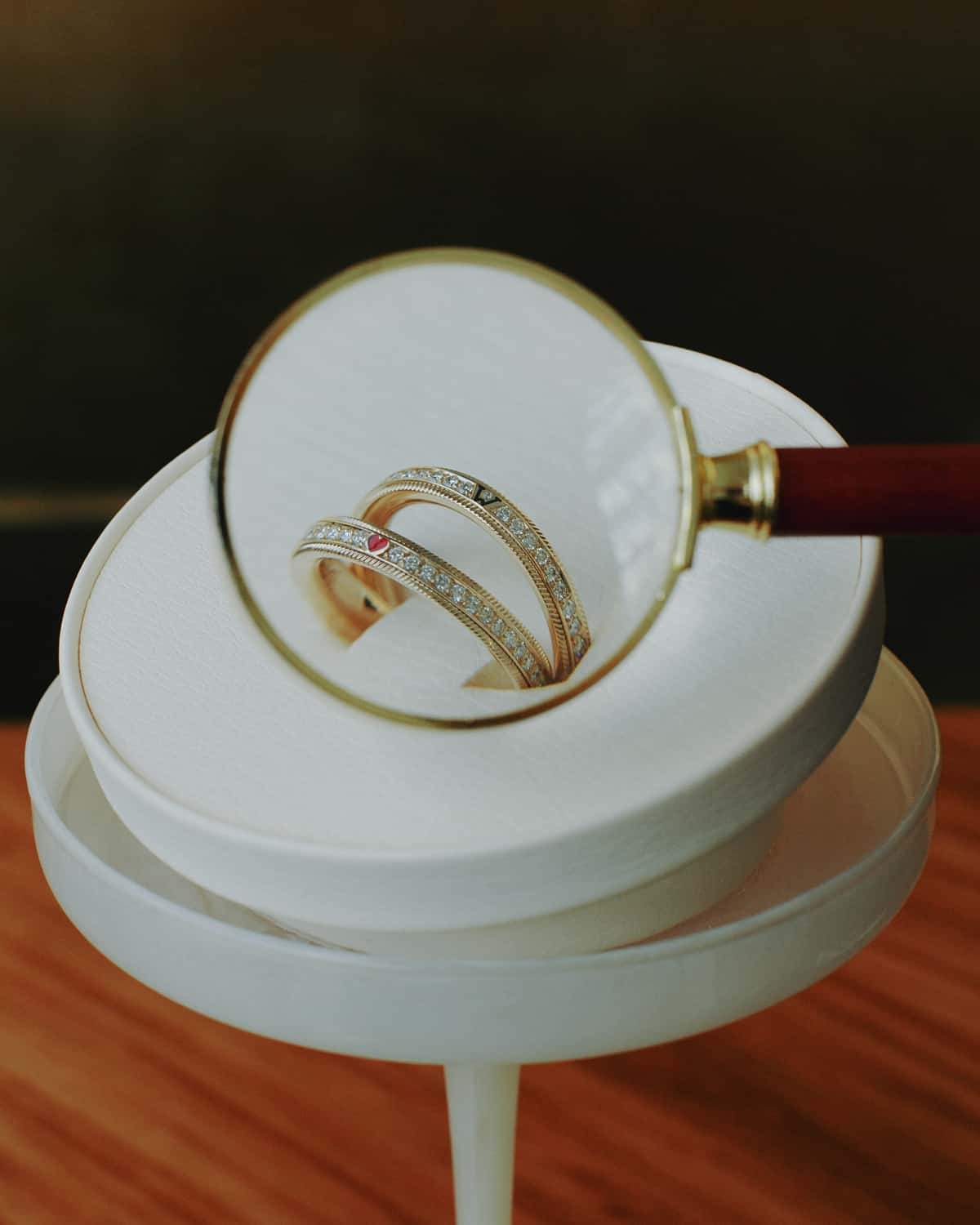PHOTOGRAPHY BY EVELYN DRAGAN
“We do everything to please our women,” says Georg Wellendorff. It’s a bold statement, but an honest one for a fourth-generation jeweler who sees it as his job to make women feel special, one necklace or ring at a time.
On a cold morning in March, Georg and his wife, Claudia, lead me through “the museum,” a hallowed space in the company’s factory and office, which is located in a boxy building in Pforzheim, Germany. This southwest German city of 120,000 became known as “the golden city” in the 19th century thanks to its jewelry and watchmaking industries, and the items on display show that Wellendorff is keeping the tradition alive. Glass cases house gorgeous pieces from the company’s vast archive—the much-lauded silk rope necklace, which Georg’s father created for his wife in 1977; colorful enamel rings, which Georg’s brother conceived for his wife in 1993. There is a gold-handled bronze sword from 600 B.C. and a bejewelled pearl and platinum necklace designed by Georg’s great-grandfather, Ernst Alexander, who founded Wellendorff in 1893 and sold his exquisite pieces to aristocrats vacationing in nearby Baden-Baden. “Every new goldsmith we hire, we show them this room,” says Georg. “We want them to make the most perfect jewelry in the world.” Adds Claudia: “We want to create things that last for generations.”

History runs deep at Wellendorff. This year, the company celebrates its 125th anniversary, and, unlike most of its competitors, it remains a small, family-owned operation—despite the numerous offers it has received to partner with larger luxury brands over the years. Georg and his brother Christoph run the company, along with their father, Hanspeter; Georg oversees manufacturing, and Christoph handles sales and marketing. (Claudia, also a principal, manages the public relations.) Christoph says their children will take over from them one day. “I could not imagine doing anything else in my life than working for my own company, my own family, and creating jewelry, first for my own wife,” Christoph tells me over lunch. “When you do something from love, you do the best.”
Quality, not quantity, is the Wellendorff M.O. “If you want to create the best, you don’t go for mass,” Christoph says. “Automatically, this excellency means you have limitations.” That attention to detail is evident from the moment I step into the brightly lit, immaculate factory upstairs, where 80 smiling employees—many of them second-generation workers—are busy crafting pieces that will sell for anywhere from $5,000 to $500,000. One woman is hunched over a microscope, polishing a red and blue enamel earring. One man is testing a bracelet clasp again and again (ultimately 40,000 times) to make sure it will never break. (“We want you to be happy for your whole life,” Claudia says.)
One woman is carefully laying a diamond necklace on a mannequin to do a quality control check. (It’s flawless.)

I stop to watch a man feed an 18-karat gold bar through a rolling mill. He hands it to me, and I take a turn pulling it through, making it a bit thinner, a bit longer. He’ll do this over and over, for weeks, until it transforms into nearly 5,500 yards of gold wire as thin as a strand of hair. This wire will be wrapped around an iron spindle, 175 yards at a time, to create the brand’s most famous item: the silk rope necklace. Hanspeter devised the piece for his wife, Eva, after she requested a necklace as soft as the silk curtain cords in her grandmother’s house. At first, he said it wasn’t possible. “Ah, but you told me you could do everything!” she responded. And he did (even if it took him two years). Because the process is so labor-intensive, the factory produces just 20 of them a day.
After my tour, I try one on in the showroom. It really does feel like silk. “I think once you achieve creating the world’s softest necklace, you just continue doing it,” Christoph says. “You just stick to your knittings, right?”
But, of course, the Wellendorff family didn’t just stick to their knittings. In 1993, they debuted spinning rings, which they call “magic rings” for the way a carefully integrated inner ring allows outer bands of gold, diamonds, and cold enamel to be spun around and around; in 1997, they also introduced the limited-edition Ring of the Year. The 2018 version is designed with the theme “Anything is possible” and features gold lotus petals studded with diamonds atop a bed of turquoise and aqua cold enamel. To celebrate the 125th anniversary, there is also a special necklace, which Christoph once again conceived as a gift for his wife, Iris, this time to mark the event of their youngest child leaving home to go to university. The theme, fittingly, is “Mein Zeit”—“My time.”

The Wellendorff woman, Christoph says, doesn’t look to celebrities to tell her what to wear; she knows what she likes. (The company has plenty of notable fans but never chases endorsements or features celebrities in its advertisements.) It used to be that men would give the jewelry to their wives; now, he says, more than half the time women are shopping for themselves. But one thing will never change: “She will treasure that ring for a lifetime, to make sure that the memory and the emotional connection she had with that ring will be passed on to her daughter or her grandchild.”
“We make people happy,” Claudia says. “To see her eyes laughing? To bring joy and happiness for a lifetime? It’s great.”
